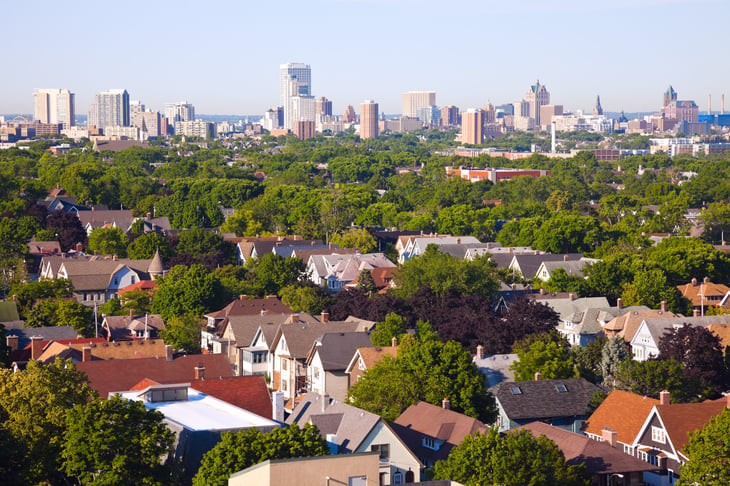
Editor's Note: This story originally appeared on Upgraded Points.
As inflation continues to squeeze household budgets and makes paying for basic living expenses challenging, many are turning to credit cards to help cope with increasing expenses.
American consumers now owe $986 billion on their credit cards, surpassing the pre-pandemic high of $927 billion. And while Americans have been relying on these lines of credit to charge both large and small purchases for decades, the record high in credit card balances highlights the effects of stubborn inflation and rising interest rates.
In an attempt to curb inflation, the Federal Reserve continues to raise the federal funds target rate, which can drive up credit card interest rates and make it more expensive to carry a credit card balance.
For over 25 years, the average commercial bank credit card interest rate has roughly hovered between 12% and 16%. But in the past year, the average rate skyrocketed to over 20%, leaving credit card consumers in a uniquely difficult financial situation.
The combination of inflation and rising interest rates makes it more expensive to pay down credit card balances in full each month, which can ultimately cause more people to live with unanticipated credit card debt.
Paying down credit card balances can be very difficult, but certain metro areas are better suited for those looking to resolve their debt. Namely, high wages, low cost of living, and especially strong job opportunities make certain areas stand out. Here are the top metro areas for paying down credit card debt.
1. Birmingham-Hoover, AL

- Composite Score: 73.3
- Cost of Living: 9.1% less than average
- Median Earnings (Cost-of-Living-Adjusted): $41,290
- Unemployment Rate: 1.8%
- Percentage of Employees That Are Full Time: 68.0%
- Share of Residents With Delinquent Credit Card Debt: 4.8%
2. Kansas City, MO-KS

- Composite Score: 71.3
- Cost of Living: 6.3% less than average
- Median Earnings (Cost-of-Living-Adjusted): $45,491
- Unemployment Rate: 2.8%
- Percentage of Employees That Are Full Time: 68.8%
- Share of Residents With Delinquent Credit Card Debt: 3.2%
3. Nashville-Davidson–Murfreesboro–Franklin, TN

- Composite Score: 65.8
- Cost of Living: 4.5% less than average
- Median Earnings (Cost-of-Living-Adjusted): $42,771
- Unemployment Rate: 2.5%
- Percentage of Employees That Are Full Time: 67.4%
- Share of Residents With Delinquent Credit Card Debt: 3.2%
4. Milwaukee-Waukesha, WI

- Composite Score: 63.4
- Cost of Living: 4.4% less than average
- Median Earnings (Cost-of-Living-Adjusted): $44,261
- Unemployment Rate: 2.5%
- Percentage of Employees That Are Full Time: 64.1%
- Share of Residents With Delinquent Credit Card Debt: 2.9%
5. Tulsa, OK

- Composite Score: 62.0
- Cost of Living: 8.0% less than average
- Median Earnings (Cost-of-Living-Adjusted): $39,902
- Unemployment Rate: 3.0%
- Percentage of Employees That Are Full Time: 66.7%
- Share of Residents With Delinquent Credit Card Debt: 4.1%
6. Oklahoma City, OK

- Composite Score: 61.7
- Cost of Living: 7.2% less than average
- Median Earnings (Cost-of-Living-Adjusted): $38,990
- Unemployment Rate: 2.7%
- Percentage of Employees That Are Full Time: 66.6%
- Share of Residents With Delinquent Credit Card Debt: 3.8%
7. Salt Lake City, UT

- Composite Score: 61.7
- Cost of Living: 3.8% less than average
- Median Earnings (Cost-of-Living-Adjusted): $42,683
- Unemployment Rate: 2.5%
- Percentage of Employees That Are Full Time: 64.3%
- Share of Residents With Delinquent Credit Card Debt: 2.6%
8. Louisville/Jefferson County, KY-IN

- Composite Score: 60.4
- Cost of Living: 8.2% less than average
- Median Earnings (Cost-of-Living-Adjusted): $41,510
- Unemployment Rate: 3.5%
- Percentage of Employees That Are Full Time: 64.4%
- Share of Residents With Delinquent Credit Card Debt: 3.9%
9. Indianapolis-Carmel-Anderson, IN

- Composite Score: 59.9
- Cost of Living: 5.0% less than average
- Median Earnings (Cost-of-Living-Adjusted): $43,388
- Unemployment Rate: 3.1%
- Percentage of Employees That Are Full Time: 66.8%
- Share of Residents With Delinquent Credit Card Debt: 3.7%
10. Memphis, TN-MS-AR

- Composite Score: 59.5
- Cost of Living: 9.4% less than average
- Median Earnings (Cost-of-Living-Adjusted): $40,413
- Unemployment Rate: 3.8%
- Percentage of Employees That Are Full Time: 68.5%
- Share of Residents With Delinquent Credit Card Debt: 6.1%
11. St. Louis, MO-IL

- Composite Score: 59.4
- Cost of Living: 3.8% less than average
- Median Earnings (Cost-of-Living-Adjusted): $43,153
- Unemployment Rate: 2.8%
- Percentage of Employees That Are Full Time: 65.7%
- Share of Residents With Delinquent Credit Card Debt: 3.4%
12. Raleigh-Cary, NC

- Composite Score: 59.1
- Cost of Living: 2.4% less than average
- Median Earnings (Cost-of-Living-Adjusted): $47,811
- Unemployment Rate: 3.1%
- Percentage of Employees That Are Full Time: 67.9%
- Share of Residents With Delinquent Credit Card Debt: 3.5%
13. Cincinnati, OH-KY-IN

- Composite Score: 58.8
- Cost of Living: 5.7% less than average
- Median Earnings (Cost-of-Living-Adjusted): $43,983
- Unemployment Rate: 3.4%
- Percentage of Employees That Are Full Time: 65.1%
- Share of Residents With Delinquent Credit Card Debt: 3.3%
14. Baltimore-Columbia-Towson, MD

- Composite Score: 58.2
- Cost of Living: 5.0% more than average
- Median Earnings (Cost-of-Living-Adjusted): $48,486
- Unemployment Rate: 2.3%
- Percentage of Employees That Are Full Time: 69.6%
- Share of Residents With Delinquent Credit Card Debt: 3.9%
15. Washington-Arlington-Alexandria, DC-VA-MD-WV

- Composite Score: 58.1
- Cost of Living: 11.3% more than average
- Median Earnings (Cost-of-Living-Adjusted): $52,638
- Unemployment Rate: 2.7%
- Percentage of Employees That Are Full Time: 69.5%
- Share of Residents With Delinquent Credit Card Debt: 2.9%
Methodology

To determine the best locations to live for paying down credit card debt, researchers at Upgraded Points analyzed the latest data from the Urban Institute’s Debt in America 2022 report, the U.S. Bureau of Economic Analysis’ Employment by County, Metro, and Other Areas dataset, the U.S. Census Bureau’s 2021 American Community Survey, the U.S. Bureau of Economic Analysis’ Regional Price Parities datasets, and the U.S. Bureau of Labor Statistics’ Local Area Unemployment Statistics.
The researchers ranked metros according to a composite score comprising the following factors and weights:
- Cost of living compared to average (35%)
- Cost-of-living-adjusted median earnings (20%)
- Unemployment rate (20%)
- Percentage of employees that are full-time (15%)
- Share of residents with delinquent credit card debt (10%)
In the event of a tie, the location with the lower cost of living compared to the national average was ranked higher. To improve relevance, only metropolitan areas with at least 100,000 residents were included.





Add a Comment
Our Policy: We welcome relevant and respectful comments in order to foster healthy and informative discussions. All other comments may be removed. Comments with links are automatically held for moderation.